Telegram
LAST UPDATED: OCTOBER 7, 2025
Overview
Telegram offers users an optional end-to-end encrypted messaging feature so that no one can access the data.
D3 SOAR is providing REST operations to function with Telegram.
Telegram is available for use in:
Known Limitations
Bots cannot view messages sent by other bots.
For webhook-related limitations, refer to I'm having problems with Webhooks.
For message-related limitations, refer to Broadcasting to Users
Connection
To connect to Telegram from D3 SOAR, follow this part to collect the required information below:
Parameter | Description | Example |
Server URL | The Telegram API server URL. | https://api.telegram.org |
API Token | The token generated by sending the /newbot command to BotFather in Telegram. | 1234*****7890 |
Configuring Telegram to Work with D3 SOAR
Begin a conversation with BotFather.
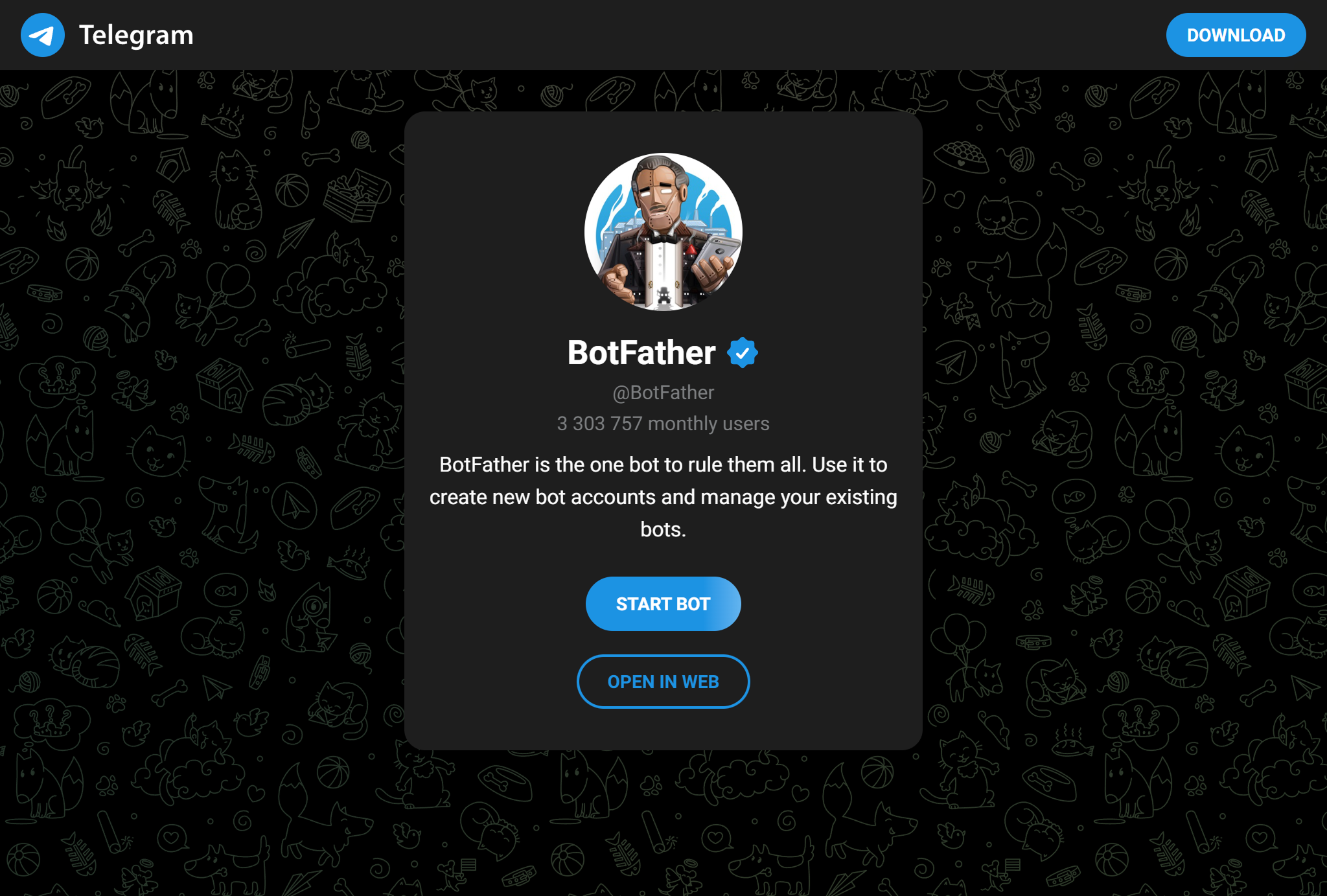
Navigate to this link.
Click the START BOT button.
Log in when prompted.
Send the /newbot command to BotFather to create a new bot.
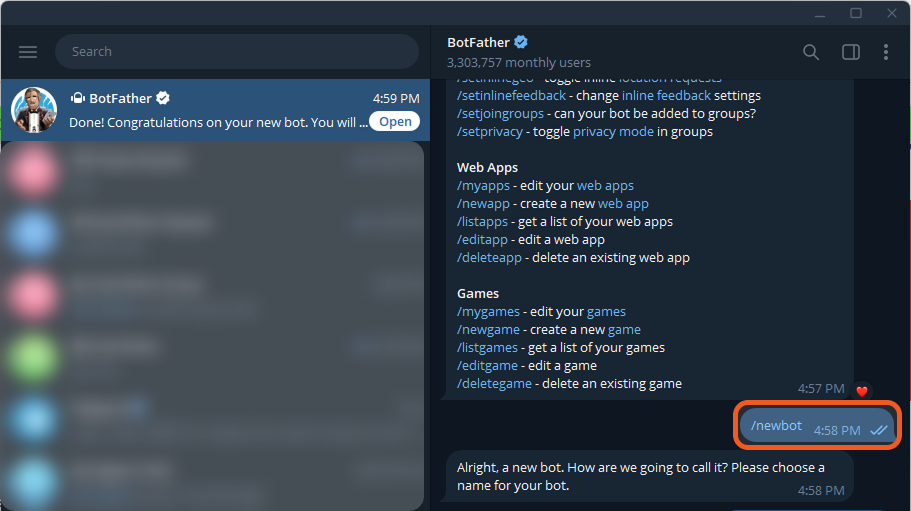
Follow the prompts and copy the token provided at the end.
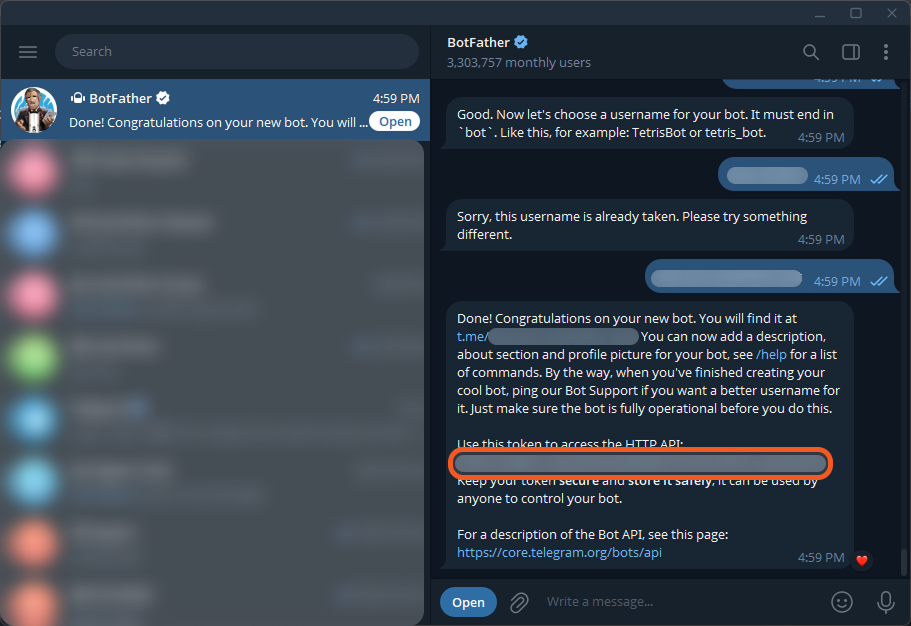
Refer to sub-step 2 under step 3i in Configuring D3 SOAR to Work with Telegram.
Configuring D3 SOAR to Work with Telegram
Log in to D3 SOAR.
Find the Telegram integration.

Navigate to Configuration on the top header menu.
Click on the Integration icon on the left sidebar.
Type Telegram in the search box to find the integration, then click it to select it.
Click on the + Connection button on the right side of the Connections section. A new connection window will appear.
Configure the following fields to create a connection to Telegram.
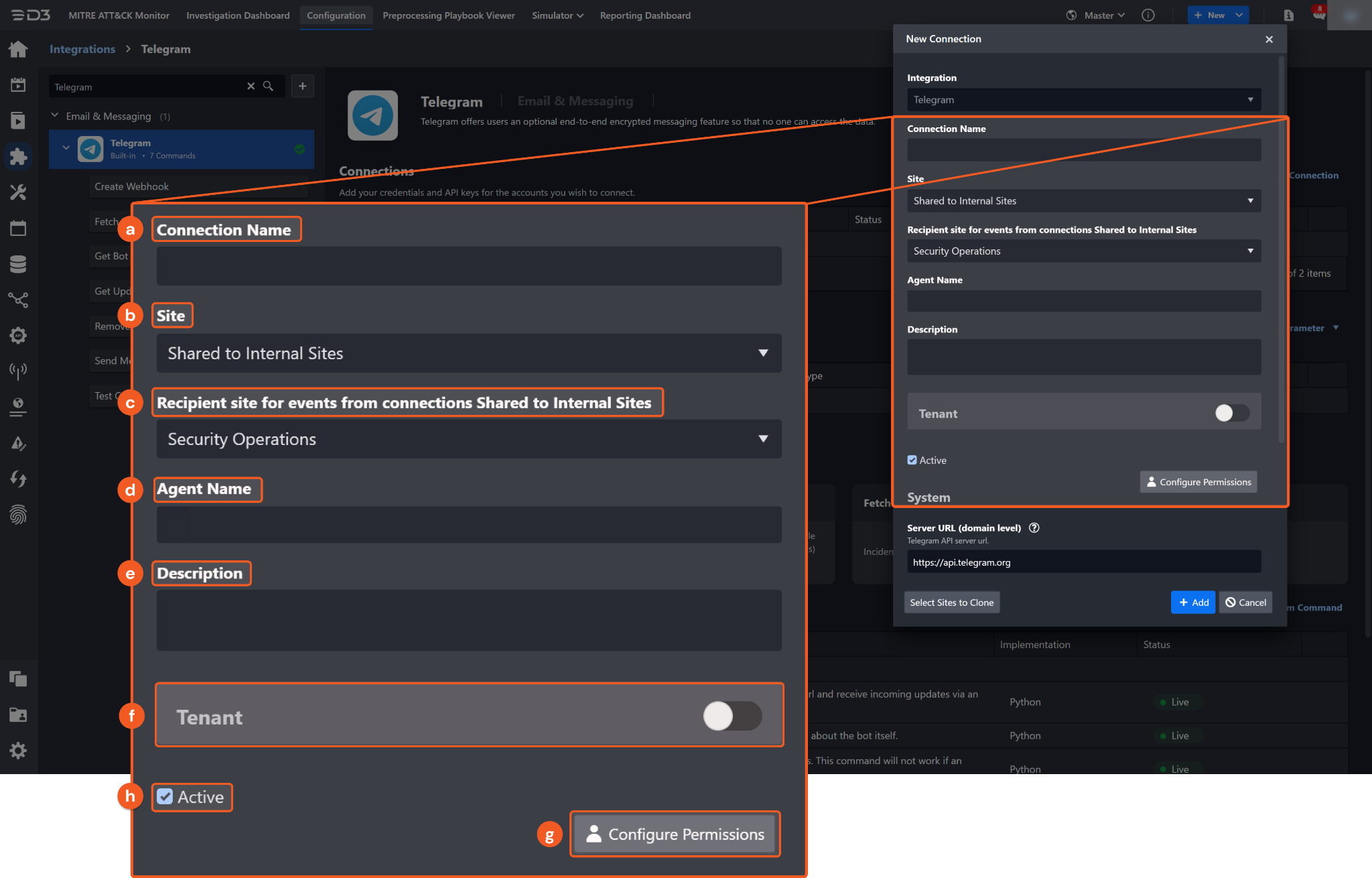
Connection Name: The desired name for the connection.
Site: The site on which to use the integration connection. Use the drop-down menu to select the site. The Share to Internal Sites option enables all internal sites to use the connection. Selecting a specific site will only enable that site to use the connection.
Recipient site for events from connections Shared to Internal Sites: This field is displayed when Share to Internal Sites is selected for the Site field, allowing selection of the internal site for deploying the integration connection.
Agent Name (Optional): The proxy agent required to build the connection. Use the dropdown menu to select the proxy agent from a list of previously configured proxy agents.
Description (Optional): The description for the connection.
Tenant (Optional): When configuring the connection from a master tenant site, users can choose the specific tenant sites with which to share the connection. Once this setting is enabled, users can filter and select the desired tenant sites from the dropdowns to share the connection.
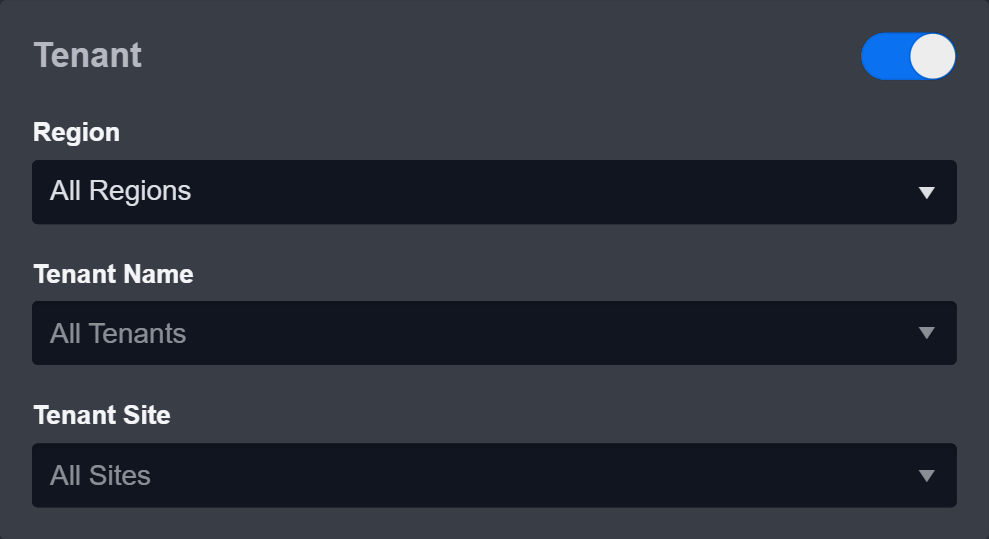
Configure User Permissions: Defines which users have access to the connection.
Active: The checkbox that enables the connection to be used when selected.
System: This section contains the parameters defined specifically for the integration. These parameters must be configured to create the integration connection.
.png?inst-v=9d16beaf-952a-4ae4-8fe8-e35f7a3745da)
1. Input the Server URL. The default value is https://api.telegram.org.
2. Input the API Token from Telegram. This is referring to the bot token. Refer to step 3 in Configuring Telegram to Work with D3 SOAR.
Enable Password Vault: An optional feature that allows users to take the stored credentials from their own password vault. Refer to the password vault connection guide if needed.
Connection Health Check: Periodically checks the connection status by scheduling the Test Connection command at the specified interval (in minutes). Available only for active connections, this feature also allows configuring email notifications for failed attempts.
Test the connection.
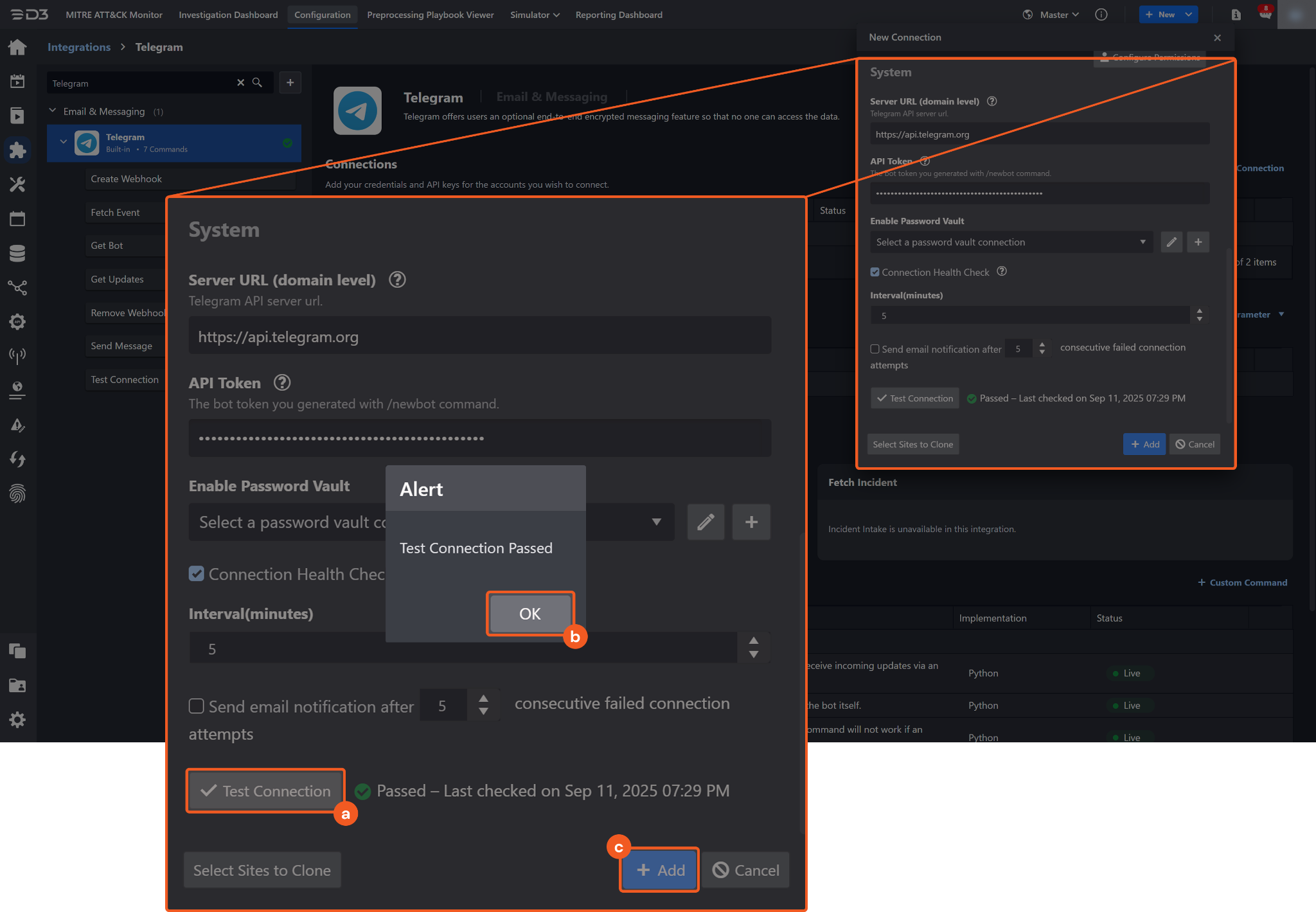
Click on the Test Connection button to verify credentials and connectivity. A success alert displays Passed with a green checkmark. If the connection fails, review the parameters and retry.
Click OK to close the alert window.
Click + Add to create and add the configured connection.
Configuring for Fetch Event
For this integration, the Fetch Event command supports only the webhook method. Events are ingested automatically from bot updates at the specified URL when the webhook is configured with the Create Webhook command. Scheduled data ingestion is not available with this command.
Follow these steps to add an API Key (or use an existing key) for data ingestion.
Copy the Request URL, Header Key, and Header Value, then append the Header Key and Value as query parameters to construct a URL that looks like the following: https://company/VSOC/api/Data/Telegram/Security%20Operations/CreateEvents?d3key=123456789
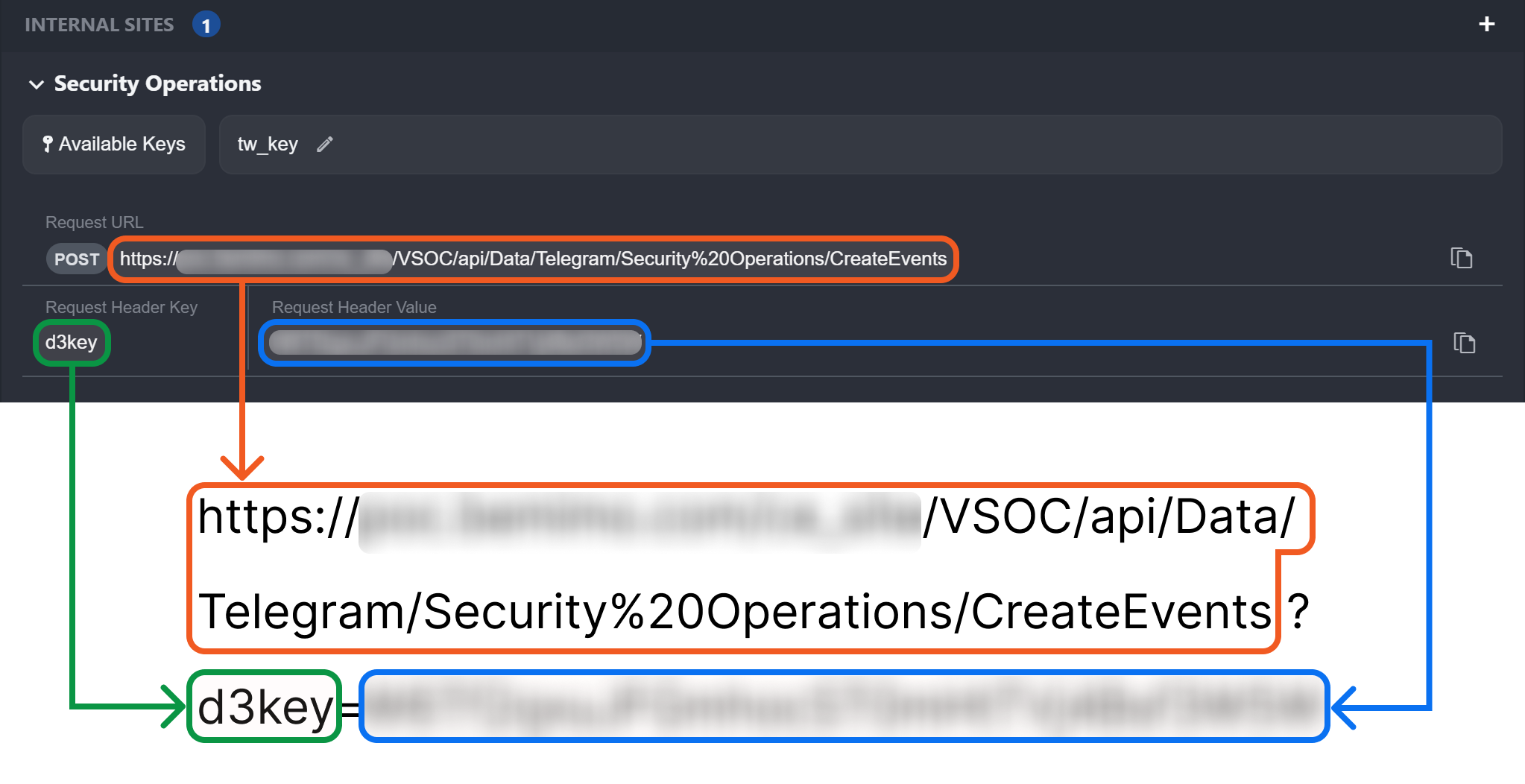
Paste the constructed URL into the Webhook URL parameter of the Create Webhook command, then execute it.
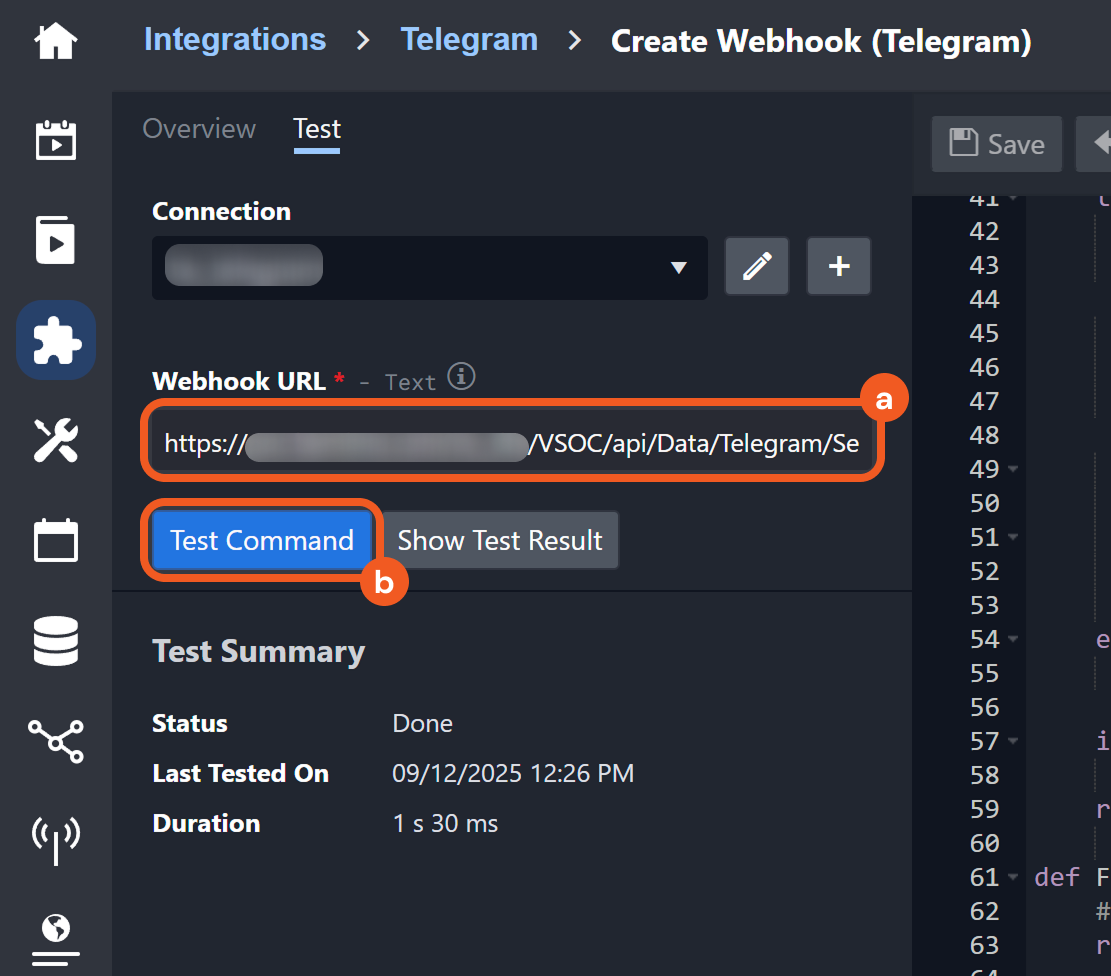
Send a test message in Telegram to the authenticated bot and verify that the event is ingested in vSOC.
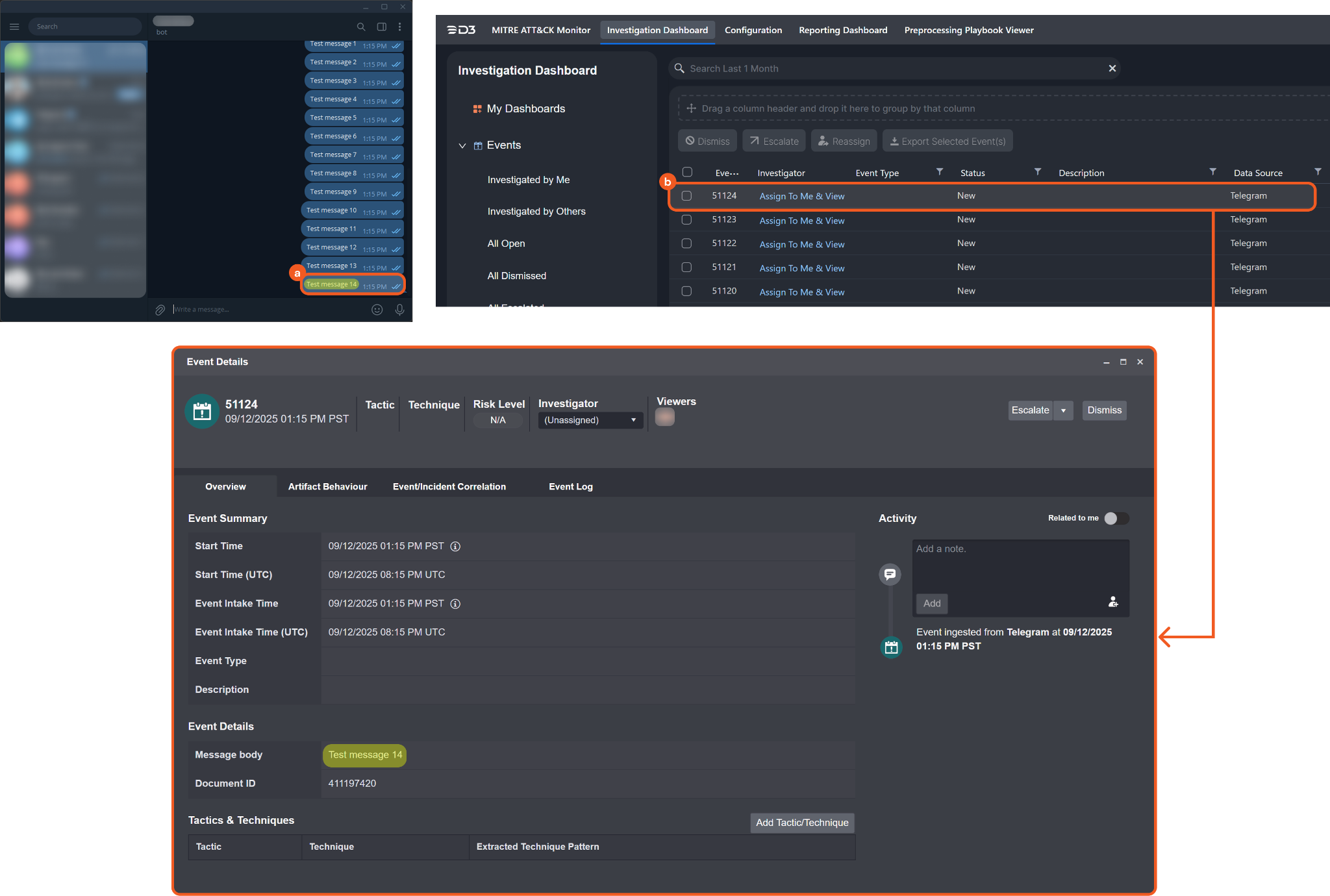
Commands
Telegram includes the following executable commands for users to set up schedules or create playbook workflows. With the Test Command function, users can execute these commands independently for playbook troubleshooting.
Integration API Note
For more information about the Telegram API, refer to the Telegram API reference.
READER NOTE
Fetch Event and Get Updates are mutually exclusive. Get Updates cannot be run while a webhook is configured for Fetch Event, and updates retrieved by one command are not available to the other. Refer to Getting updates for more information.
Create Webhook
The vSOC webhook URL to receive incoming updates through an outgoing webhook. This command must execute successfully to enable event ingestion into vSOC through the Fetch Event command (webhook only).
Input
Input Parameter | Required/Optional | Description | Example |
Webhook URL | Required | The HTTPS webhook URL to which Telegram will send updates. For on-premises vSOC instances, the webhook URL must be exposed to public access. | https://company/VSOC/api/Data/Telegram/Security%20Operations/CreateEvents?d3key=***** |
Output
To view the sample output data for all commands, refer to this article.
Error Handling
If the Return Data displays Failed, an Error tab will appear in the Test Result window.
The error tab contains the details responded from D3 SOAR or third-party API calls, including Failure Indicator, Status Code, and Message. This can help locate the root cause of a command failure.
Parts in Error | Description | Example |
Failure Indicator | Indicates the command failure that happened at a specific input and/or API call. | Create Webhook failed. |
Status Code | The response code issued by the third-party API server or the D3 SOAR system that can be used to locate the corresponding error category. For example, if the returned status code is 401, the selected connection is unauthorized to run the command. The user or system support would need to check the permission setting in the Telegram portal. Refer to the HTTP Status Code Registry for details. | Status Code: 400. |
Message | The raw data or captured key error message from the integration API server about the API request failure. | Message: Bad Request: bad webhook: IP address ***.***.***.*** is reserved. |
Error Sample Data Create Webhook failed. Status Code: 400. Message: Bad Request: bad webhook: IP address ***.***.***.*** is reserved. |
Fetch Event
Ingests Telegram updates as D3 events in real time when the authenticated bot receives messages, commands, or files in direct or group chats. Updates are delivered through the webhook set using the Create Webhook command. Scheduled data ingestion is not available for this command. Refer to Configuring for Fetch Event for more information.
Input
N/A
Output
To view the sample output data for all commands, refer to this article.
Fetch Event Field Mapping
See Field Mappings.
The Telegram system integration includes pre-configured field mappings for the default event source.
The Default Event Source is the default system-provided set of field mappings applied when the fetch event command is executed. It includes a Main Event JSON Path, which is the JSONPath expression that points to the base array of event objects. The source field path continues from this array to locate the required data.
The Main Event JSON Path can be viewed by clicking on the Edit Event Source button.

The root object represents the event, and the key update_id denotes the Document ID field. As such, the full JSONPath expression to extract the Document ID is $.update_id.
The pre-configured field mappings are detailed below:
Field Name | Source Field |
Document ID | .update_id |
Start Time | .message.date |
Description | .message.chat.title |
Message body | .message.text |
Error Handling
If the Return Data displays Failed, an Error tab will appear in the Test Result window.
The error tab contains the details responded from D3 SOAR or third-party API calls, including Failure Indicator, Status Code, and Message. This can help locate the root cause of a command failure.
Parts in Error | Description | Example |
Failure Indicator | Indicates the command failure that happened at a specific input and/or API call. | Fetch Event failed. |
Status Code | The response code issued by the third-party API server or the D3 SOAR system that can be used to locate the corresponding error category. For example, if the returned status code is 401, the selected connection is unauthorized to run the command. The user or system support would need to check the permission setting in the Telegram portal. Refer to the HTTP Status Code Registry for details. | Status Code: N/A |
Message | The raw data or captured key error message from the integration API server about the API request failure. | Message: N/A |
Error Sample Data Fetch Event failed. Status Code: N/A Message: N/A |
Get Bot
Retrieves basic information on the authenticated bot.
Input
N/A
Output
To view the sample output data for all commands, refer to this article.
Error Handling
If the Return Data displays Failed, an Error tab will appear in the Test Result window.
The error tab contains the details responded from D3 SOAR or third-party API calls, including Failure Indicator, Status Code, and Message. This can help locate the root cause of a command failure.
Parts in Error | Description | Example |
Failure Indicator | Indicates the command failure that happened at a specific input and/or API call. | Get Bot failed. |
Status Code | The response code issued by the third-party API server or the D3 SOAR system that can be used to locate the corresponding error category. For example, if the returned status code is 401, the selected connection is unauthorized to run the command. The user or system support would need to check the permission setting in the Telegram portal. Refer to the HTTP Status Code Registry for details. | Status Code: 404. |
Message | The raw data or captured key error message from the integration API server about the API request failure. | Message: Not Found. |
Error Sample Data Get Bot failed. Status Code: 404. Message: Not Found. |
Get Updates
Retrieves updates (i.e., messages, commands, or files) from direct or group chats for the authenticated bot. This command cannot be used if a webhook is already configured. Run the Remove Webhook command before executing this command.
Input
Input Parameter | Required/Optional | Description | Example |
Limit | Optional | The maximum number of updates to retrieve in one request. Values from 1 to 100 are accepted. By default, the value is 100. | 10 |
Offset | Optional | The update ID of the first update to retrieve. This parameter acts as an offset in the update queue. Set it to one greater than the last processed update ID to prevent duplicates. By default, Telegram returns all unconfirmed updates. A negative value retrieves only the most recent updates and discards all earlier ones. | 1*****6 |
Output
To view the sample output data for all commands, refer to this article.
Error Handling
If the Return Data displays Failed, an Error tab will appear in the Test Result window.
The error tab contains the details responded from D3 SOAR or third-party API calls, including Failure Indicator, Status Code, and Message. This can help locate the root cause of a command failure.
Parts in Error | Description | Example |
Failure Indicator | Indicates the command failure that happened at a specific input and/or API call. | Get Updates failed. |
Status Code | The response code issued by the third-party API server or the D3 SOAR system that can be used to locate the corresponding error category. For example, if the returned status code is 401, the selected connection is unauthorized to run the command. The user or system support would need to check the permission setting in the Telegram portal. Refer to the HTTP Status Code Registry for details. | Status Code: 409. |
Message | The raw data or captured key error message from the integration API server about the API request failure. | Message: Conflict: can't use getUpdates method while webhook is active; use deleteWebhook to delete the webhook first. |
Error Sample Data Get Updates failed. Status Code: 409. Message: Conflict: can't use getUpdates method while webhook is active; use deleteWebhook to delete the webhook first. |
Remove Webhook
Removes the previously configured outgoing webhook.
Input
N/A
Output
To view the sample output data for all commands, refer to this article.
Error Handling
If the Return Data displays Failed, an Error tab will appear in the Test Result window.
The error tab contains the details responded from D3 SOAR or third-party API calls, including Failure Indicator, Status Code, and Message. This can help locate the root cause of a command failure.
Parts in Error | Description | Example |
Failure Indicator | Indicates the command failure that happened at a specific input and/or API call. | Remove Webhook failed. |
Status Code | The response code issued by the third-party API server or the D3 SOAR system that can be used to locate the corresponding error category. For example, if the returned status code is 401, the selected connection is unauthorized to run the command. The user or system support would need to check the permission setting in the Telegram portal. Refer to the HTTP Status Code Registry for details. | Status Code: 404. |
Message | The raw data or captured key error message from the integration API server about the API request failure. | Message: Not Found. |
Error Sample Data Remove Webhook failed. Status Code: 404. Message: Not Found. |
Send Message
Sends a text message to the specified Telegram user, group chat, or public channel. The authenticated bot must be an admin to send messages in a channel.
READER NOTE
Chat ID is a required parameter to run this command.
Run the Fetch Event or Get Updates command to obtain the Chat ID. Chat IDs for direct and group chats can be found in the raw data at:
$.message.chat.id for Fetch Event
$.result[*].message.chat.id for Get Updates
Users can obtain the channel username in the following steps:
.png?inst-v=9d16beaf-952a-4ae4-8fe8-e35f7a3745da)
1. Open the desired public channel.
2. Click the
 icon.
icon.3. Select the View Channel Info option.
4. Copy the public channel link without the t.me/ prefix. The remaining portion is the channel username.
Ensure to add an @ symbol to the copied username before entering it in the Chat ID parameter (i.e., @analystchannel).
Input
Input Parameter | Required/Optional | Description | Example |
Chat ID | Required | The unique identifier of the target user, group chat, or the channel username in the @channelname format. Chat ID can be obtained using the Fetch Event or Get Updates command. | -1*****4 |
Message | Required | The message content to be sent. | Hello World |
Output
To view the sample output data for all commands, refer to this article.
Error Handling
If the Return Data displays Failed, an Error tab will appear in the Test Result window.
The error tab contains the details responded from D3 SOAR or third-party API calls, including Failure Indicator, Status Code, and Message. This can help locate the root cause of a command failure.
Parts in Error | Description | Example |
Failure Indicator | Indicates the command failure that happened at a specific input and/or API call. | Send Message failed. |
Status Code | The response code issued by the third-party API server or the D3 SOAR system that can be used to locate the corresponding error category. For example, if the returned status code is 401, the selected connection is unauthorized to run the command. The user or system support would need to check the permission setting in the Telegram portal. Refer to the HTTP Status Code Registry for details. | Status Code: 400. |
Message | The raw data or captured key error message from the integration API server about the API request failure. | Message: Bad Request: chat not found. |
Error Sample Data Send Message failed. Status Code: 400. Message: Bad Request: chat not found. |
Test Connection
Allows users to perform a health check on an integration connection. Users can schedule a periodic health check by selecting Connection Health Check when editing an integration connection.
Input
N/A
Output
Output Type | Description | Return Data Type |
Return Data | Indicates one of the possible command execution states: Successful or Failed. The Failed state can be triggered by any of the following errors:
More details about an error can be viewed in the Error tab. | String |
Error Handling
If the Return Data displays Failed, an Error tab will appear in the Test Result window.
The error tab contains the details responded from D3 SOAR or third-party API calls, including Failure Indicator, Status Code, and Message. This can help locate the root cause of a command failure.
Parts in Error | Description | Example |
Failure Indicator | Indicates the command failure that happened at a specific input and/or API call. | Test Connection failed. Failed to check the connector. |
Status Code | The response code issued by the third-party API server or the D3 SOAR system that can be used to locate the corresponding error category. For example, if the returned status code is 401, the selected connection is unauthorized to run the command. The user or system support would need to check the permission setting in the Telegram portal. Refer to the HTTP Status Code Registry for details. | Status Code: 404. |
Message | The raw data or captured key error message from the integration API server about the API request failure. | Message: Not Found. |
Error Sample Data Test Connection failed. Failed to check the connector. Status Code: 404. Message: Not Found. |
